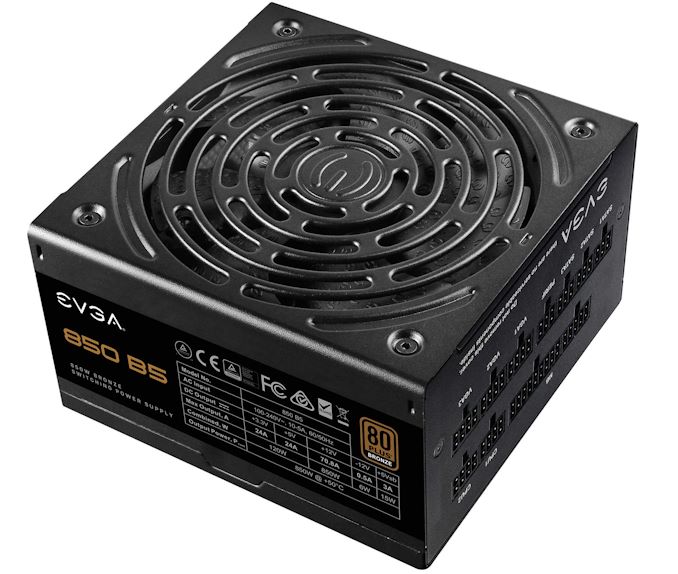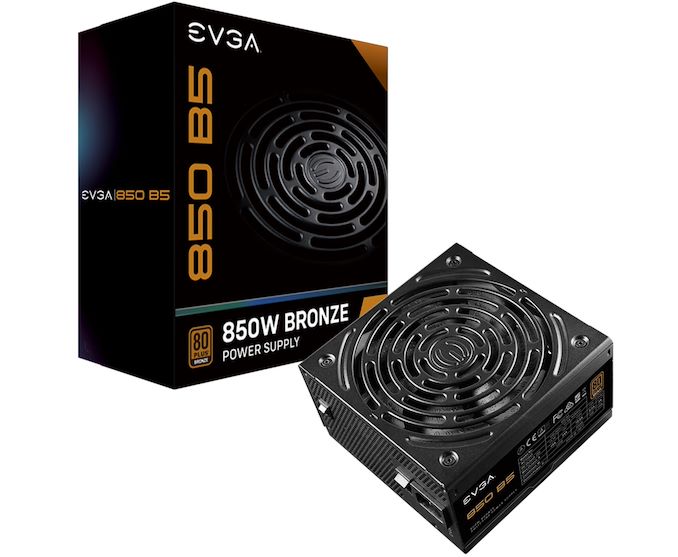EVGA Launches B5 Modular PSUs: 80Plus Bronze At Up to 850 W
by Anton Shilov on March 4, 2020 12:00 PM EST- Posted in
- PSUs
- EVGA
- Cases/Cooling/PSUs
- 80Plus Bronze

EVGA this week has introduced a new family of entry-level, 80Plus power supplies. Promise to bring together strong performance, a rich feature set, and a relatively low price, EVGA’s modular B5-series PSUs are designed to tick all of the boxes expected for a basic PSU in 2020.
The EVGA B5-series PSU family includes 550 W, 650 W, 750 W, and 850 W models, and are compliant with the latest ATX12 v2.52/EPS12V specifications. Fully modular, the most powerful SKU has six 8-pin PCIe power connectors, the 750 W model features four 8-pin PCIe power plugs, the 650 W flavor has three, whereas the entry 550 W model has two 8-pin PCIe power connectors. Obviously, the PSUs have SATA as well as Molex plugs too. The new power supplies correspond to the 80Plus Bronze requirements, so they are they are mandated to be 81% - 88% efficient under a 20% or 50% load as well as 81% - 85% efficient under a 100% load.
EVGA’s latest B5-series PSUs use 100% Japanese capacitors on 750 W and 850 W models (and some on less powerful SKUs), and feature an no-fan/ECO mode that shuts down the 135-mm fluid-dynamic bearing fan under low and medium loads. In addition, the power supplies feature a comprehensive set of protection technologies that includes OVP (Over Voltage Protection), UVP (Under Voltage Protection), OCP (Over Current Protection), OPP (Over Power Protection), SCP (Short Circuit Protection), and OTP (Over Temperature Protection).
| EVGA B5-Series PSUs Output Specifications | ||||||||||
| 550 W | 650 W | 750 W | 850W | |||||||
| Rated | Combined | Rated | Combined | Rated | Combined | Rated | Combined | |||
| +3.3V | 24 A | 120 W | 24 A | 120 W | 24 A | 120 W | 24 A | 120 W | ||
| +5V | 24 A | 24 A | 24 A | 24 A | ||||||
| +12V | 45.8 A | 550 W | 54.1 A | 650 W | 62.5 A | 750 W | 70.8 A | 850 W | ||
| -12V | 0.5 A | 6 W | 0.5 A | 6 W | 0.5 A | 6 W | 0.5 A | 6 W | ||
| +5Vsb | 3 A | 15 W | 3 A | 15 W | 3 A | 15 W | 3 A | 15 W | ||
| Total Power | 550 W | 650 W | 750 W | 850 W | ||||||
EVGA’s B5-series power supplies measure 150x50x86 mm, which is pretty typical for mid-capacity PSUs, so they should easily fit into virtually any standard ATX case. And as mentioned earlier, the PSUs are fully modular, so they provide additional flexibility to system builders.
| EVGA B5-Series PSUs Connectivity Specifications | ||||
| Connector type | 550 W | 650 W | 750 W | 850 W |
| ATX 24 Pin | 1 | |||
| EPS 4+4 Pin | 1 | 2 | ||
| EPS 8 Pin | - | |||
| PCIe 6+2 Pin | 2 | 3 | 4 | 6 |
| SATA | 6 | 9 | ||
| 4P Molex | 3 | |||
| Floppy | 1 | |||
EVGA’s B5-series PSUs are immediately available directly from the company. The cheapest model, the 550 W version, is priced at $79.99, whereas the most powerful 850 W SKU is priced at $129.99. The power supplies are covered by a five-year warranty, which is typical for inexpensive PSUs.
Related Reading:
- Phanteks Unveils AMP: Inexpensive Modular PSUs up to 750W
- EVGA Enters SFX Market with SuperNOVA GM SFX PSUs
- Going BIG: EVGA’s SuperNova 2000W G+ Power Supply
- The SilverStone Strider Platinum ST1200-PTS 1200W PSU Review: Small in Size, Big on Compliance
- SilverStone’s 1000W SFX-L PSU: When Less Is More
Source: EVGA












17 Comments
View All Comments
ikjadoon - Wednesday, March 4, 2020 - link
Anandtech, unrelated; can we get an article about the upcoming ATX12VO specification?The 24-pin connector is dead.
5V is dead.
3.3V is dead.
At least from the PSU end. Motherboards, of course, will still convert 12V to provide for old SATA & USB devices.
https://custompc.raspberrypi.org/articles/new-psu-...
I pray to God this lands better than BTX because ATX12V is ancient & ridiculous in 2020.
ikjadoon - Wednesday, March 4, 2020 - link
Intel spec sheet: https://www.intel.com/content/dam/www/public/us/en...DanNeely - Wednesday, March 4, 2020 - link
HP's been doing it for years on at least some of their desktops. I'm glad to see it's finally being standardized. I am a bit surprised they're going all in though; my "if anyone cared enough to update ATX" notional v.next connector was around 12 pins because it kept single 3.3/5v wires to support USB and legacy power loads; but would've had the advantage of being forward/back compatible with a 12 to 24 pin adapter plug. The use of 12V standby instead of 5V standby makes that impossible here.With 50% (or 100% if 12Vsb can be double purposed) more power I'm hopeful that some low power mITX systems might be able to simplify wiring even more by dropping the need for a separate 4-pin 12V connector.
I am a bit concerned about what's going to happen if/when this makes its way from OEMland to consumer systems. My concern is that we're going to see a regression in efficiency; PSU makers have to use quality components to make the 3.3/5v rails to meet *0+ standards; MOBO makers I can see cheaping out on lower end models to save a buck (just like when they use a crappy decade old audio chip) and using inefficient parts that waste a decent amount of power or ones so underspecced they can't support more than 1 or 2 HDDs.
I also half-expect hybrid models that do 12VO to the mobo, but still have a few connectors for SATA strings to support the higher low voltage needs of people making large NAS systems.
Korguz - Thursday, March 5, 2020 - link
" I pray to God this lands better than BTX because ATX12V is ancient & ridiculous in 2020 " how so ?DanNeely - Thursday, March 5, 2020 - link
The 24pin ATX cable/connector are huge and packed full of virtually unused 3.3/5v wires and grounds to support them. Back in the mid 90s when Pentium CPUs ran on 3.3v and everything else ran on 5V that power mix made a lot of sense. Today when only USB uses 5v, and 3.3v is an occasionally used option for PCIe cards (upto 10W/slot - mostly for legacy reasons - it made porting PCI cards easier) and for a few odds and ends (TPM) its a giant waste of space and resources.-12V is even worse; it's only needed for the tiny fraction of systems that still use RS232; 99.9% of the blue wires and -12V sources in PSUs are never used for anything at all; but because the ATX spec has been largely frozen in time since the early 2000's, with only bigger 12V connectors being added for the last 15 years.
lmcd - Thursday, March 5, 2020 - link
Thanks for this explainer, I assumed something like this was the case but didn't know for sure.office movers - Thursday, April 2, 2020 - link
i like this company mobile .its looking good<a href="https://swiftwayservices.com/">Moving services near me</a>